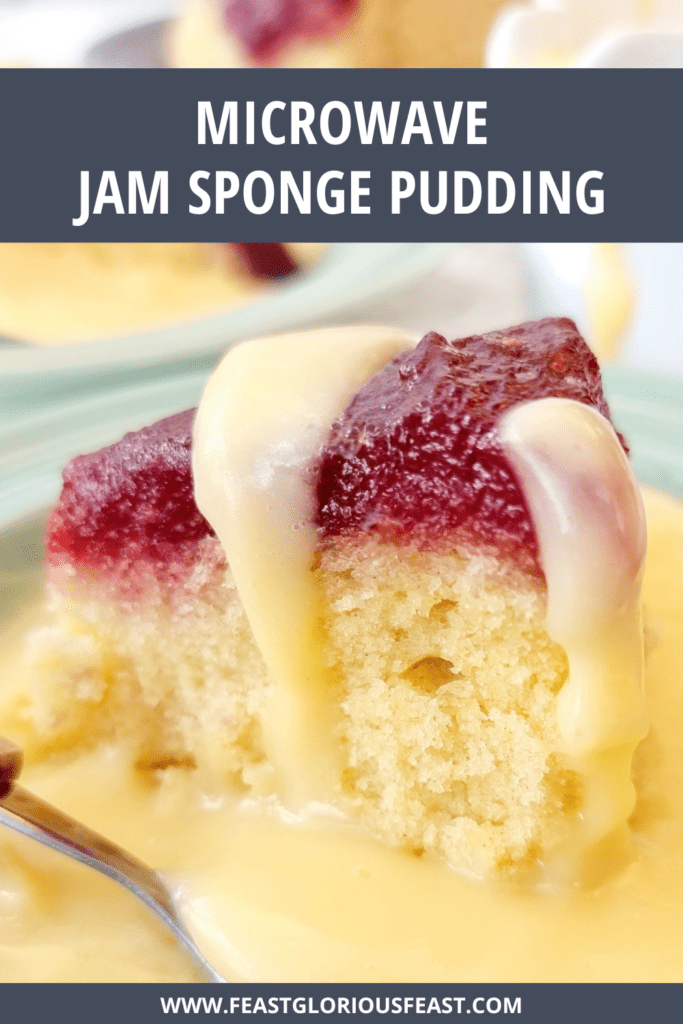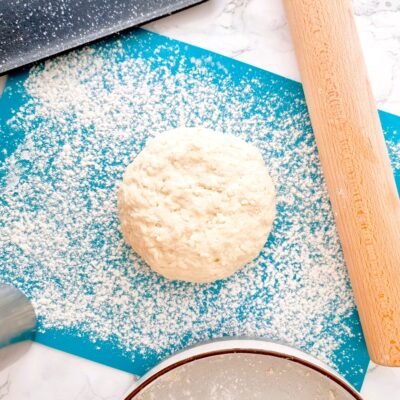Use this Traditional Suet Pastry Recipe to make all manner of sweet and savoury treats. It can be baked or steamed and even used to make fluffy dumplings for stew. You can use beef or vegetarian suet as you please – this simple recipe is quick, easy and delicious either way.

This post may contain affiliate links. Please refer to my Disclosures Page for more details.
It feels very old school and one that’s been left in the past, but suet pastry is really due a return to favour. It’s incredibly simple to make, doesn’t requite a tonne of chilling before it can be used and it’s just as good in sweet as well as savoury dishes.
What Exactly is Suet?
Suet is the hard fat found around the kidneys of sheep and cows. Traditionally it would be grated or minced and then used in recipes. The suet that we now buy in packets is dehydrated to make it shelf stable and tossed in some kind of powdery starch or flour so it doesn’t clump. It is usually beef suet which is sold like this. It doesn’t have any kind of meaty flavour however.
If using animal fat doesn’t tickle your taste buds, you can buy a vegetable oil based substitute suet which is packaged in exactly the same way. It can be used interchangeably with the regular beef suet. And it is what I generally tend to use.
What you shouldn’t do it try and use fresh suet interchangeably with packet suet as the texture, fat and water content is different. Trying to swap it one for one in a recipe like this won’t go well.
How to Use Suet Pastry
Suet pastry crisps up on the outside when baked but stays soft and almost fluffy inside. Suet pastry contains raising agent by way of the self-raising flour which helps to create this light texture. It doesn’t have layers of flakiness like a puff pastry and doesn’t crumble like shortcrust.
Unlike most other pastries, I really don’t find it nearly as delicious when cold. So I only usually plan to use suet pastry when I’m baking or cooking something that is going to be served hot.

Baked Suet Pastry
You can use suet pastry in many of the same ways that you can use shortcrust or puff. Try making pies, turnovers and sausage rolls. You can also use it as a tart base although I wouldn’t necessarily use it every instance – juicy fruit tarts are the best time to use it here.
Suet Pastry Sausage Rolls Recipe
Steamed Suet Puddings
Unlike other pastries, suet pastry can also be served soft and without the crisp outer. It is traditionally cooked by being steamed. This is how classic “puddings” like steak and kidney puddings are cooked. The little pies have suet crust all the way underneath, round the sides and on top. Made in a basin, the filled puddings are steamed on the stovetop until fully cooked.
Suet Pastry Rolls
There are also more freeform ways of using suet pastry. One of the most common is jam roly-poly. The suet pastry is rolled out, spread with jam and then rolled up on itself into a spiral. The roll is wrapped in a tea towel and steamed until cooked. It is more common to wrap in greaseproof paper and foil nowadays.
This rolled method can also be used to make savoury dishes, a very traditional one involves bacon and onions – a true British classic. You can bake these rolls as well as steam them – this is often a family and personal preference.
Dumplings
Exactly the same dough is used to make traditional suet dumpling. Roll the pastry into small balls and add to a stew or casserole, cover with a lid and allow to simmer for around 20 minutes until they’re big and puffy.

Ingredients for Traditional Suet Pastry
Suet
You can use any packet suet – either beef or vegetarian. Atora is the big name brand here in the UK but most supermarkets have an own label option that is usually significantly cheaper. I’ve not identified any difference in quality of the actual suet so this is what I tend to use.
Whatever brand you choose, you need to sieve it. I tested this recipe several times and because there was so much rice flour in the recipe, measuring the same amount of actual suet every time was nearly impossible.
I sieved a 200g packet of suet and ended up with 175g of actual suet and 25g flour. There will still be some flour coating the suet – this is fine and not a problem. The idea is to simply get rid of the unnecessary bulk. I do have a theory that more flour is used now than in the past to cheaply bulk up the packets but I don’t actually have anyway of testing this.

Flour
Suet pastry uses flour with a raising agent which is how it becomes soft and fluffy. It is most common to use self-raising flour which already contains the right amount of baking powder.
You can make your own self-raising flour by adding 1tsp for every 100g plain flour.
Self-raising flour is known as self-rising flour in the US. But it also contains a little salt. So if yo are using this, reduce the amount of salt in the recipe a little.
It is important when making doughs and pastries to note that the absorbency of flour can vary wildly from brand to brand, batch to batch and can be affected by room temperature, humidity and even altitude. So when adding liquids it is most important to judge the pastry on the finished texture which might mean adding a little more flour.

Salt
I mostly preach about using sea salt flakes in my cooking and baking but in this instance I use fine salt. This allows for a better distribution of the salt throughout the pastry.
Milk
I’ve just stated “milk” in the recipe. This is because you can use which milk you prefer. I usually use skimmed milk but whatever you use will have very similar results.
As I’ve mentioned above, flour can absorb liquids quite differently depending on a multitude of factors. So the amount of milk given in the recipe is really more of a guide than an absolute. You may need to add a little more or a little less to get a soft but not quite sticky dough.

Be Flexible
There isn’t a huge amount of flexibility with a classic recipe such as this. I’ve already said that you can use either type of suet and any kind of milk. Beyond that, your only really option is to add other flavours.
For savoury dishes, you can add spices or herbs. I like to add oregano to pie and pudding pastry but you really can experiment. How about a curried chicken steamed pudding with a coriander spiked pastry.
For sweet dishes, you can add citrus like lemon zest or spices like ginger or mixed spice. Think a roly-poly with mincemeat with a spiced crust for the festive season. Or a ginger pastry for a lemon curd roly-poly.
Vegetarian Suet Pastry
If you use vegetarian suet, the pastry will be suitable for vegetarians.
Vegan Suet Pastry
In addition to using vegetarian suet, you will also need to switch the milk for something plant based. Make sure to use something unsweetened and without a specific flavour unless it marries with the other ingredients in your recipe.
Allergy Friendly Suet Pastry
This recipe is free from egg and nuts.
Gluten Free Suet Pastry: Some suet is marked gluten free and others are not so you must check the packet. Atora brand currently (April 2024) use wheat flour in their suet so that needs to be avoided.
The rest of the main supermarket brands really vary whether they use rice or wheat flour so you must look carefully. Some like Tesco aren’t even consistent within their own range – they use wheat in the beef suet and rice flour in the veggie option.
You will also need to use a gluten-free flour blend. Look for a self-raising option if possible but you can add baking powder if needed.
Dairy Free Suet Pastry: To make this recipe dairy free, you just need to switch the milk for a plant-based option. As always, opt for something unsweetened and without a strong flavour.
Please note that this recipe may contain other allergens not referred to above and any variations suggested have not been tested unless otherwise stated. For more information regarding any dietary information provided on this website, please refer to my Nutritional Disclaimer.

Equipment Notes for Traditional Suet Pastry
You don’t need any electronic equipment to make this pastry. I would actually advise against using a food processor of any kind as you risk breaking up the chunks for suet as you mix/blend.
So all you need is some baking basics. A bowl, measuring equipment like scales, spoons and a jug for the liquid and something to start the mixing. My preference is a silicone spatula as they’re great for getting everything off a surface without scratching.
I’ve mentioned using a wide bowl for the mixing. I often use a pie dish or similar when I’m taking photos for recipes because it’s much easier to photograph and show you what’s happening in a wide shallow bowl. But in this case it is a really good idea as you have space to give the pastry a light knead within the bowl. Which I must prefer to do than by dirtying another surface.
A comprehensive list of the equipment used to make this recipe is included in the main recipe card below. Click on any item to see an example. There are no hard and fast rules so many items can be sensibly substituted to achieve the same results.

Get Ahead
You don’t need to make suet pastry in advance of wanting to use it. Unlike other pastries, it doesn’t need to be excessively chilled before being used.
But you absolutely can if you wish to. It will store well wrapped in the fridge for several days. Or you can really wrap it well and freeze it.
Once thawed, pastry which has been frozen may need patting dry with a little kitchen paper and may need an extra shake of flour to remove any stickiness.
Traditional Suet Pastry Tips
You must trust your instincts when making pastry like this. It is much more important that you end up with a soft and pliable but just-not-sticky dough than it is to be a slave to quantities. People have been making pastry like this for hundreds of years by eyeballing it. Use my recipe of course but it is simply a starting point.
You do need to knead the dough until it comes together into a nice ball. Again trust your instincts here, you will know when it’s ready – we’re talking a minute – this is pastry, not bread so you don’t want to be developing the gluten in the flour by over-kneading it.
When you come to use the pastry, if you are rolling it out but finding it a bit tough – just leave it to sit for a few minutes to relax. You’ll be really surprised how much difference this makes when you go back to it.

Don’t forget to let me know in the comments if you try making this recipe – I want to know what you think and if you made any substitutions, how did it turn out?
Still Have Questions?
Simple! Just contact me and I will do my best to help as quickly as I am able. Head over to my Contact Me page, any of my social media channels or post a comment at the bottom of this page and I’ll see what I can do.
Pin Traditional Suet Pastry Recipe For Later
Hit one of the share buttons to save this page to your Pinterest boards so you can come back and find it at anytime!

Keep Up to Date
Make sure you SUBSCRIBE to my newsletter and avoid missing out on any of my newest and bonus content. Don’t worry, I promise not to spam you or bombard you too often. Plus you’ll receive a copy of my FREE 7 Day International Meal Plan!
Also please don’t forget to follow me over on my social media channels over at Facebook, Twitter, Instagram and Pinterest. I love to interact with my followers and I’d love you to share my content with your friends too.
The Recipe
Traditional Suet Pastry Recipe
Ingredients
- 90 g Suet - beef or vegetarian, sieved
- 200 g Self Raising Flour (Self-Rising)
- 1 tsp Fine Salt
- 150 ml Milk
Instructions
- Measure 90g Sieved Suet, 200g Self Raising Flour and 1 tsp Fine Salt into a mixing bowl. I prefer a shallow flat bottomed bowl that I have room to knead the dough in.

- Mix everything together really well so the salt and suet are well distributed.

- Measure out 150ml Milk and add around half to the flour/suet.

- Use a spatula to mix everything together. I like to do this gently and a little slowly to give the milk time to be fully absorbed. The dough will be shaggy looking at this stage, likely with a fair amount of unabsorbed flour. Note: You can use your hands rather than a spatula if you prefer, especially towards the end of the mixing process.

- Add more milk and keep repeating the mixing process until all of the flour has been absorbed. If you add a little too much and the dough is very sticky, you can add a little more flour.

- Knead the dough for around a minute until it has all fully come together and isn't sticky to the tough. Again you can add a sprinkle more flour at this stage if needed.

- Form the dough into a ball, cover and allow to rest for 5 minutes before using.

























Janice says
Thanks for reminding me just how easy this pastry is to make and just how good it is. I made a pie at the weekend and used your recipe, absolutely perfect!
Karen says
Thanks for sharing this recipe, I haven’t made suet pastry for years, but your instructions were really straightforward. I added some grated vintage cheddar to the pastry which worked a treat with the savoury chicken pie filling.